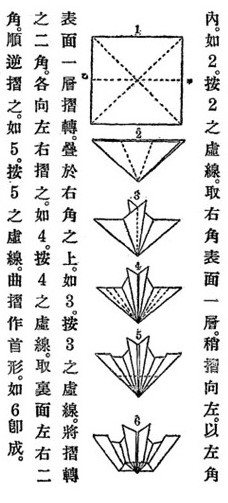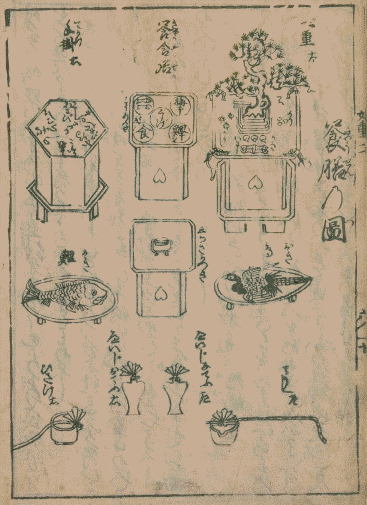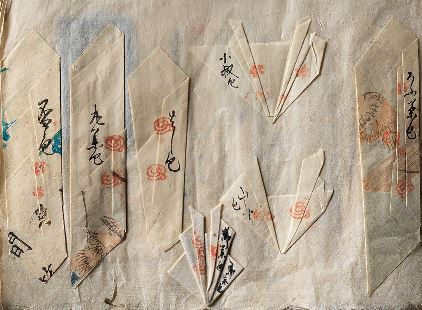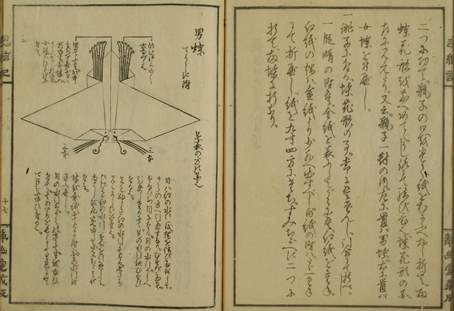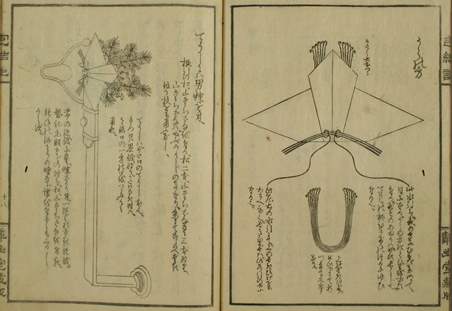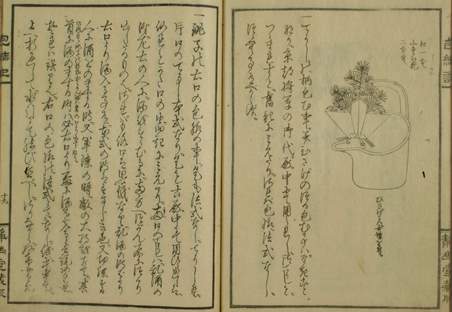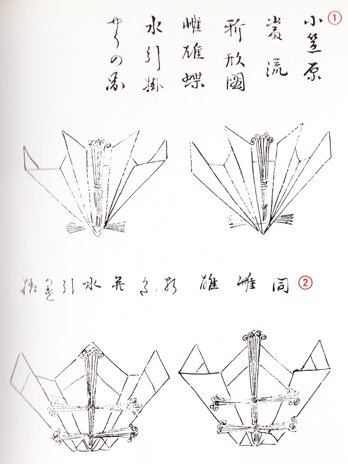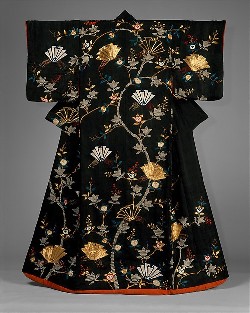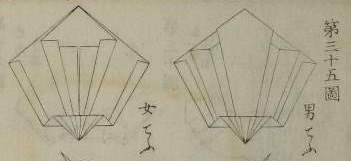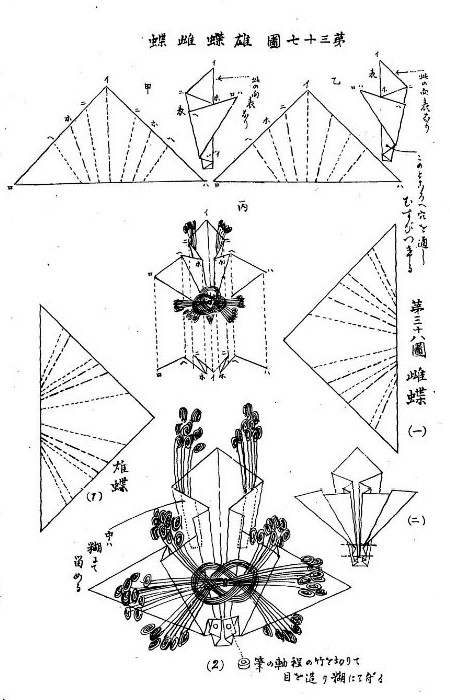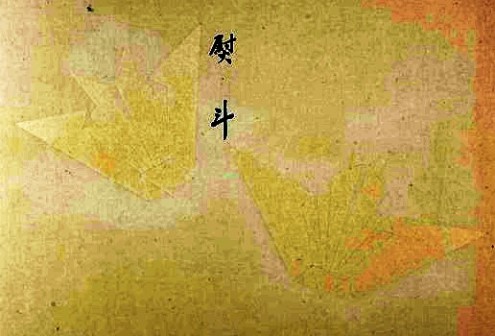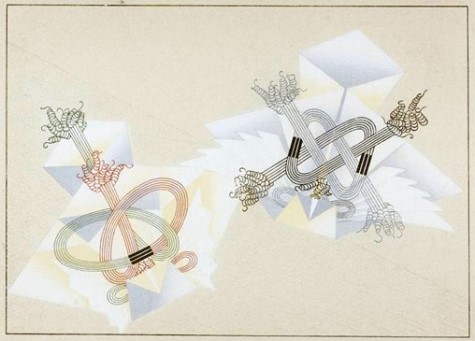| The Public Paperfolding History Project
x |
|||||||
| Ocho and Mecho | |||||||
| This
page attempts to record what is known about the origin
and history of the Japaanese traditional paperfolds known
as ocho and mecho - decorative stylised male and female
butterflies which are attached to sake bottles and
kettles as part of traditional Japanese wedding
ceremonies. Please contact me if you know any of this
information is incorrect or if you have any other
information that should be added. Thank you. Ocho and mecho are a form of noshi. I have found it difficult to discover much definite information about this subject. I do not read Japanese so that my information is largely culled from sources in English. In the edition of the Kan No Mado edited by Julia and Martin Brossman, published in 1961 by the Pinecone Press, the editors quote from an 1871 English translation of the 'Shorei Hikki' (Record of Ceremonies) by A B Mitford describing a ceremony in which sake is poured from two kettles, each of which is decorated with a paper butterfly, one in gold and one in silver, into another kettle. The editors describe this as a Shinto marriage ceremony, although I am not convinced that this is the case. (Wikipedia - https://en.wikipedia.org/wiki/Shinto_wedding - states that 'The Shinto wedding is a modern invention. The first mention of a wedding in a Shinto manual was in 1872; weddings are not reported until the 1880s.' ) ********** In China (and in publications by Chinese authors) 1917 Designs for Ocho and Mecho appear in 'Xu Zhe zhi tu shuo' (More Illustrated Paperfolding) by Yongxiang Shi, which was published by the Commercial Press in Shanghai in 1917.
********** In Japan (and in publications by Japanese authors) 1680 There is a short poem by Iharu Saikaku 'Rosei-ga yume-no cho-wa orisue' in the 'Ittyuya Dokugin Onsenku" (4000 Haikus Recited Alone All Day and Night) which dates to 1680. This can be translated as 'The butterflies in a beggar's dream would be folded paper' and may be a reference to the ocho and mecho, although it is also conceivable that it refers to some other kind of paper butterfly of which we now know nothing. ********** 1692 The Japanese book 'Onna Chohoki' (Women's Treasury) published in 1692 contains several illustrations of folded paper butterflies attached to sake kettles and other containers, both on their own and seemingly in use during a wedding ceremony. One specimen page is shown below.
********** 1697 The Metropolitan Museum in New York has in its collection a scrapbook album of tsutsumi, accession number 2013.248.1–.25, which appears to include ocho and mecho folds similar to those illustrated in the Kan no mado (see below), about which the Met says, 'According to the inscriptions, this set of models served as the initiation into the art of origata for Kikuchi Fujiwara no Takehide by an Ogasawara master, and is dated the third month of 1697.
********** 1764 Several pages in the 'Hoketsuki', a treatise on the folding of formal wrappers in the tradition of the Ogasawara school of etiquette, by Ise Sadatake, published in 1764, show pictures of ocho and mecho, one of which is attached to the spout of a sake kettle.
********** 1830 Illustrations of Ocho and Mecho appear in 'Eitai Ozassho Sanzeso', a book of woodcut prints published in 1830. ********** 1830 - 1844 Illustrations of ocho and mecho appear in 'Kyoka Hayabiki Setsuyoshu', a book of woodcut prints by Yashima Gakutei said to date from between 1830 and 1844. ********** 1845 Drawings of ocho and mecho, in the style of the Ogasawara school of etiquette, also occur in the Kan No Mado, which was written in 1845.
********** 1868 Ocho and mecho designs in gold and silver are also featured in the design on a wedding ukichake (or outer robe) which is in the collection of the Metropolitan Museum in New York and which can be dated to the late 18th–early 19th century during the Edo period (1615–1868). See https://www.metmuseum.org/art/collection/search/65607 The Mets commentary states, 'Wedding uchikake are decorated with auspicious motifs, such as the folded-paper butterflies depicted here in pairs, male and female, to represent the newly wedded couple. Folded-paper butterflies attached to thin strips of paper were also used to adorn presents and may be the origins of this pattern. “Butterfly” in Japanese is pronounced cho, which sounds like the word for “long” (?), so the motif also symbolizes a long and happy marriage.'
********** 1885 Diagrams for Ocho and Mecho appear in 'Kindergarten Shoho' (Preliminary Kindergarten) by Iijima Hanjuro, which was copyrighted on October 4th Meiji 17 (1884) and published by Fukuda Senzo in August of Meiji 18 (1885).
********** 1907 Diagrams appear in 'Shukou Tebikigusa : Kokumin Kyoiku Origami Yuihimo' by Ishin Nishigaki, which was published by Meguro Shoten in Nagaoka in 1907.
********** 1935 'Origami Moyo, Book Two' by Kawarazaki Kodo, which was published in Japan in 1935, contains two prints showing ocho and mecho (here titled 'utto').
********** |
|||||||
